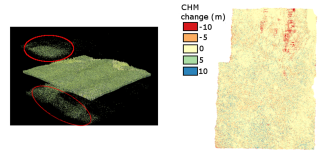Data Notification
AOP Lidar Data Quality Notification
September 29, 2022
AOP lidar data products collected with the Optech Galaxy Prime Lidar sensor between 2021 and 2022 were found to have abnormally high noise levels, which our standard noise filtering algorithms did not correctly classify. The tables below summarize the affected data products, and the sites and publication months with affected data. Most of the data affected are available provisionally, although two sites released in RELEASE-2022 (MOAB 2021 and MLBS 2021) were also affected.
The figure below displays examples of the noise that remains in the point cloud data. The noise-related artifacts are clearly identifiable when differencing the Canopy Height Model contained in the Ecosystem Structure (DP3.30015.001) data product between two subsequent visits. In the image to the right below, the noise issues are most prevalent in the north-east corner, where the bright red areas are located, indicating there was a large difference observed in tree heights between subsequent years. The issue has variable severity depending partly on the atmospheric conditions during the time of acquisition, and does not generally affect the entire site. Note that the majority of affected sites are still viable.

Left: Colorized point cloud showing some of the atmospheric noise still remaining within highlighted regions. Right: Difference between Canopy Height Models (in meters) collected in 2021 and 2020 at the D17 site TEAK. Red areas in the northern area highlight where noise was mis-classified.
The AOP science team is currently working with Teledyne Optech to resolve this issue, and the lidar data will be re-processed. The issue is expected to be corrected in RELEASE-2023 for the data sets included in RELEASE-2022. Provisional data will be updated as soon as the noise artifacts have been eliminated. Previously released data containing the noise artifacts will still be available on the data portal until the corrected data is published.
Please use the Contact Us form for further inquiries regarding this issue, and include the term "INC0059048" in the body of your request.
Table 1: Affected data products
| Data Product ID | Data Product Name |
|---|---|
| DP1.30003.001 | Discrete return LiDAR point cloud |
| DP3.30024.001 | Elevation - LiDAR |
| DP3.30025.001 | Slope and Aspect - LiDAR |
| DP3.30015.001 | Ecosystem structure |
| DP1.30001.001 | LiDAR slant range waveform |
Table 2: Affected sites and years
| Domain | Site | Publish Year-Month | Release Status |
|---|---|---|---|
| D13 | MOAB | 2021-04 | RELEASE-2022 |
| D07 | GRSM | 2021-06 | PROVISIONAL |
| D07 | MLBS | 2021-06 | RELEASE-2022 |
| D17 | SOAP | 2021-07 | PROVISIONAL |
| D17 | TEAK | 2021-07 | PROVISIONAL |
| D16 | ABBY | 2021-07 | PROVISIONAL |
| D16 | WREF | 2021-07 | PROVISIONAL |
| D16 | MCRA | 2021-07 | PROVISIONAL |
| D02 | SCBI | 2021-08 | PROVISIONAL |
| D02 | BLAN | 2021-08 | PROVISIONAL |
| D02 | SERC | 2021-08 | PROVISIONAL |
| D03 | JERC | 2021-09 | PROVISIONAL |
| D03 | OSBS | 2021-09 | PROVISIONAL |
| D03 | DSNY | 2021-09 | PROVISIONAL |
| D11 | CLBJ | 2022-05 | PROVISIONAL |
| D11 | PRIN | 2022-05 | PROVISIONAL |
| D11 | OAES | 2022-05 | PROVISIONAL |
| D02 | BLAN | 2022-05 | PROVISIONAL |
| D02 | SCBI | 2022-05 | PROVISIONAL |
| D02 | SERC | 2022-05 | PROVISIONAL |